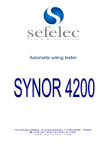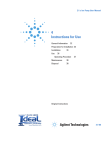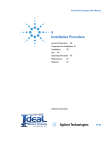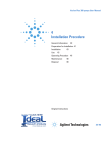Download Firex PADC240 Smoke Alarm User Manual
Transcript
APG-XT APG-HPD Operating Manual Internal APG (Analog Programming) Interface for XT/HPD Series Programmable DC Power Supply Operating Manual for Internal APG (Analog Programming) Interface for XT 60 Watt and HPD 300 Watt Series Programmable DC Power Supply Limited Warranty What does this warranty cover and how long does it last? This Limited Warranty is provided by Xantrex Technology, Inc. (“Xantrex”) and covers defects in workmanship and materials in your Internal APG Interface card. This warranty lasts for a Warranty Period of 5 years from the date of purchase at point of sale to you, the original end user customer. What will Xantrex do? Xantrex will, at its option, repair or replace the defective product free of charge, provided that you notify Xantrex of the product defect within the Warranty Period, and provided that Xantrex through inspection establishes the existence of such a defect and that it is covered by this Limited Warranty. Xantrex will, at its option, use new and/or reconditioned parts in performing warranty repair and building replacement products. Xantrex reserves the right to use parts or products of original or improved design in the repair or replacement. If Xantrex repairs or replaces a product, its warranty continues for the remaining portion of the original Warranty Period or 90 days from the date of the return shipment to the customer, whichever is greater. All replaced products and all parts removed from repaired products become the property of Xantrex. Xantrex covers both parts and labor necessary to repair the product, and return shipment to the customer via a Xantrex-selected non-expedited surface freight within the contiguous United States and Canada. Alaska and Hawaii are excluded. Contact Xantrex Customer Service for details on freight policy for return shipments outside of the contiguous United States and Canada. How do you get service? If your product requires troubleshooting or warranty service, contact your merchant. If you are unable to contact your merchant, or the merchant is unable to provide service, contact Xantrex directly at: ii Phone: 604 422 8595 Toll Free North America: 1 800 667 8422 Fax: 604 421 3056 Email: [email protected] Operating Manual for APG for XT/HPD Series Power Supply Direct returns may be performed according to the Xantrex Return Material Authorization Policy described in your product manual. For some products, Xantrex maintains a network of regional Authorized Service Centers. Call Xantrex or check our website to see if your product can be repaired at one of these facilities. In any warranty claim, dated proof of purchase must accompany the product and the product must not have been disassembled or modified without prior written authorization by Xantrex. Proof of purchase may be in any one of the following forms: • • • The dated purchase receipt from the original purchase of the product at point of sale to the end user, or The dated dealer invoice or purchase receipt showing original equipment manufacturer (OEM) status, or The dated invoice or purchase receipt showing the product exchanged under warranty What does this warranty not cover? This Limited Warranty does not cover normal wear and tear of the product or costs related to the removal, installation, or troubleshooting of the customer’s electrical systems. This warranty does not apply to and Xantrex will not be responsible for any defect in or damage to: a. the product if it has been misused, neglected, improperly installed, physically damaged or altered, either internally or externally, or damaged from improper use or use in an unsuitable environment; b. the product if it has been subjected to fire, water, generalized corrosion, biological infestations, and high input voltage from lightning strikes; c. the product if repairs have been done to it other than by Xantrex or its authorized service centers (hereafter “ASCs”); d. the product if it is used as a component part of a product expressly warranted by another manufacturer; e. the product if its original identification (trade-mark, serial number) markings have been defaced, altered, or removed. Release 1.0 iii Disclaimer Product THIS LIMITED WARRANTY IS THE SOLE AND EXCLUSIVE WARRANTY PROVIDED BY XANTREX IN CONNECTION WITH YOUR XANTREX PRODUCT AND IS, WHERE PERMITTED BY LAW, IN LIEU OF ALL OTHER WARRANTIES, CONDITIONS, GUARANTEES, REPRESENTATIONS, OBLIGATIONS AND LIABILITIES, EXPRESS OR IMPLIED, STATUTORY OR OTHERWISE IN CONNECTION WITH THE PRODUCT, HOWEVER ARISING (WHETHER BY CONTRACT, TORT, NEGLIGENCE, PRINCIPLES OF MANUFACTURER’S LIABILITY, OPERATION OF LAW, CONDUCT, STATEMENT OR OTHERWISE), INCLUDING WITHOUT RESTRICTION ANY IMPLIED WARRANTY OR CONDITION OF QUALITY, MERCHANTABILITY OR FITNESS FOR A PARTICULAR PURPOSE. ANY IMPLIED WARRANTY OF MERCHANTABILITY OR FITNESS FOR A PARTICULAR PURPOSE TO THE EXTENT REQUIRED UNDER APPLICABLE LAW TO APPLY TO THE PRODUCT SHALL BE LIMITED IN DURATION TO THE PERIOD STIPULATED UNDER THIS LIMITED WARRANTY. IN NO EVENT WILL XANTREX BE LIABLE FOR ANY SPECIAL, DIRECT, INDIRECT, INCIDENTAL OR CONSEQUENTIAL DAMAGES, LOSSES, COSTS OR EXPENSES HOWEVER ARISING WHETHER IN CONTRACT OR TORT INCLUDING WITHOUT RESTRICTION ANY ECONOMIC LOSSES OF ANY KIND, ANY LOSS OR DAMAGE TO PROPERTY, ANY PERSONAL INJURY, ANY DAMAGE OR INJURY ARISING FROM OR AS A RESULT OF MISUSE OR ABUSE, OR THE INCORRECT INSTALLATION, INTEGRATION OR OPERATION OF THE PRODUCT. Exclusions If this product is a consumer product, federal law does not allow an exclusion of implied warranties. To the extent you are entitled to implied warranties under federal law, to the extent permitted by applicable law they are limited to the duration of this Limited Warranty. Some states and provinces do not allow limitations or exclusions on implied warranties or on the duration of an implied warranty or on the limitation or exclusion of incidental or consequential damages, so the above limitation(s) or exclusion(s) may not apply to you. This Limited Warranty gives you specific legal rights. You may have other rights which may vary from state to state or province to province. iv Operating Manual for APG for XT/HPD Series Power Supply Information WITHOUT LIMITING THE GENERALITY OF THE FOREGOING, UNLESS SPECIFICALLY AGREED TO BY IT IN WRITING, XANTREX a. MAKES NO WARRANTY AS TO THE ACCURACY, SUFFICIENCY OR SUITABILITY OF ANY TECHNICAL OR OTHER INFORMATION PROVIDED IN MANUALS OR OTHER DOCUMENTATION PROVIDED BY IT IN CONNECTION WITH THE PRODUCT; AND b. ASSUMES NO RESPONSIBILITY OR LIABILITY FOR LOSSES, DAMAGES, COSTS OR EXPENSES, WHETHER SPECIAL, DIRECT, INDIRECT, CONSEQUENTIAL OR INCIDENTAL, WHICH MIGHT ARISE OUT OF THE USE OF SUCH INFORMATION. THE USE OF ANY SUCH INFORMATION WILL BE ENTIRELY AT THE USER’S RISK. WARNING: Please refer to your product user manual for limitations on uses of the product. Limitations Specifically, please note that this power supply is not intended for use in connection on Use with life support systems and Xantrex makes no warranty or representation in connection with any use of the product for such purposes. Xantrex Technology, Inc. 8999 Nelson Way Burnaby, British Columbia Canada V5A 4B5 Information Please record the following information when you first open your Power Supply About Your package: Power Model Number ______________________________________________ Supply Serial Number ______________________________________________ Purchased From ______________________________________________ Purchase Date ______________________________________________ Release Release 1.0 (2002-07) Copyright © 2002 Xantrex Technology Inc. All rights reserved. Printed in Canada Release 1.0 v Warnings Warnings and cautions are defined and formatted in this manual as shown below. and Cautions WARNING Describes a potential hazard which could result in injury or death, or, a procedure which, if not performed correctly, could result in injury or death. ! CAUTION Describes a procedure which, if not performed correctly, could result in damage to data, equipment, or systems. Power Supply Safety WARNING—High Energy and High Voltage Exercise caution when using and calibrating a power supply. High energy levels can be stored at the output voltage terminals on a power supply in normal operation. In addition, potentially lethal voltages exist in the power circuit and on the output and sense connectors of a power supply with a rated output greater than 40 V. Filter capacitors store potentially dangerous energy for some time after power is removed. ! vi CAUTION Operate the power supply in an environment free of flammable gases or fumes. To ensure that the power supply’s safety features are not compromised, use the power supply as specified in this manual and do not substitute parts or make any unauthorized modifications. Contact the service technician for service and repair help. Repairs must be made by experienced service technicians only. Operating Manual for APG for XT/HPD Series Power Supply About This Manual This manual is for the internal APG (Analog Programming) interface card for the XT and HPD Series DC output power supplies. This manual provides you with descriptions and specifications, user options, and configuration instructions which enable you to manage the power supply from an external source. This manual is designed for the user who is familiar with basic electrical theory especially as it applies to the operation of power supplies. This implies a recognition of Constant Voltage and Constant Current operation modes and the control of input and output power, as well as the observance of safe techniques while effecting supply or pin connections and any changes in switch settings. Refer to your power supply manual for installation, configuration, and operating procedures for your power supply. Main Sections Section 1 Features and Specifications Describes the power supply and lists its features and specifications. Section 2 Installation and Configuration Goes through basic setup procedures. Describes inspection, and cleaning procedures. Includes additional options for calibration adjustment. Section 3 Operation Details information on remote programming, indicators and protections. Manual Revisions The current release of this manual is listed below. Updates may be issued as an addendum. Release 1.0 (2002-07) Release 1.0 vii About This Manual viii Operating Manual for APG for XT/HPD Series Power Supply Contents About This Manual . . . . . . . . . . . . . . . . . . . . . . . . . . . . . . . . . . . . . . . . . . . . . . . . . . . vii Section 1. Features and Specifications Description . . . . . . . . . . . . . . . . . . . . . . . . . . . . . . . . . . . . . . . . . . . . . . . . . . . . . . . . . 11 Section 2. Installation and Configuration Introduction . . . . . . . . . . . . . . . . . . . . . . . . . . . . . . . . . . . . . . . . . . . . . . . . . . . . . . . . . 13 Features . . . . . . . . . . . . . . . . . . . . . . . . . . . . . . . . . . . . . . . . . . . . . . . . . . . . . . . . . . . 11 Specifications . . . . . . . . . . . . . . . . . . . . . . . . . . . . . . . . . . . . . . . . . . . . . . . . . . . . . . . 11 Initial Inspection . . . . . . . . . . . . . . . . . . . . . . . . . . . . . . . . . . . . . . . . . . . . . . . . . . . . . 13 Configuring . . . . . . . . . . . . . . . . . . . . . . . . . . . . . . . . . . . . . . . . . . . . . . . . . . . . . . . . . 14 Front panel . . . . . . . . . . . . . . . . . . . . . . . . . . . . . . . . . . . . . . . . . . . . . . . . . . . . . 14 Rear Panel . . . . . . . . . . . . . . . . . . . . . . . . . . . . . . . . . . . . . . . . . . . . . . . . . . . . . 15 Rear Panel Switch (S1) Defaults . . . . . . . . . . . . . . . . . . . . . . . . . . . . . . . . . . . . 15 Rear Panel J5 Connector . . . . . . . . . . . . . . . . . . . . . . . . . . . . . . . . . . . . . . . . . . . . . . 16 J5 Connector Pin Assignments . . . . . . . . . . . . . . . . . . . . . . . . . . . . . . . . . . . . . 16 Calibration Adjustment . . . . . . . . . . . . . . . . . . . . . . . . . . . . . . . . . . . . . . . . . . . . . . . . 17 Section 3. Operation Remote Programming. . . . . . . . . . . . . . . . . . . . . . . . . . . . . . . . . . . . . . . . . . . . . . . . . 19 Programming Output Voltage with a 0-10Vdc Voltage Source . . . . . . . . . . . . . 19 Programming Output Voltage with a 0-10k Resistance . . . . . . . . . . . . . . . . . . . 20 Programming Output Current with a 0-10 Vdc Voltage Source . . . . . . . . . . . . . 20 Programming Output Current with a 0-10k Resistance . . . . . . . . . . . . . . . . . . . 21 Programming with a Fixed +10V Reference . . . . . . . . . . . . . . . . . . . . . . . . . . . 21 Readback and Status Indicators. . . . . . . . . . . . . . . . . . . . . . . . . . . . . . . . . . . . . . . . . 22 Voltage and Current Readback . . . . . . . . . . . . . . . . . . . . . . . . . . . . . . . . . . . . . 22 Operating Mode Status . . . . . . . . . . . . . . . . . . . . . . . . . . . . . . . . . . . . . . . . . . . 22 Remote Programming Status. . . . . . . . . . . . . . . . . . . . . . . . . . . . . . . . . . . . . . . 22 Output Fail Flag . . . . . . . . . . . . . . . . . . . . . . . . . . . . . . . . . . . . . . . . . . . . . . . . . 22 Overvoltage Protection (OVP) . . . . . . . . . . . . . . . . . . . . . . . . . . . . . . . . . . . . . . . . . . 23 OVP Flag . . . . . . . . . . . . . . . . . . . . . . . . . . . . . . . . . . . . . . . . . . . . . . . . . . . . . . 23 Setting the OVP Trip Level. . . . . . . . . . . . . . . . . . . . . . . . . . . . . . . . . . . . . . . . . 23 TTL Shutdown . . . . . . . . . . . . . . . . . . . . . . . . . . . . . . . . . . . . . . . . . . . . . . . . . . . . . . 24 Tracking . . . . . . . . . . . . . . . . . . . . . . . . . . . . . . . . . . . . . . . . . . . . . . . . . . . . . . . . . . . 25 Release 1.0 ix Contents x Operating Manual for APG for XT/HPD Series Power Supply Section 1. Features and Specifications Description The Analog Programming (APG) Interface is an internal option card for analog programming of XT and HPD Series DC power supplies with a 0-10Vdc programming source or a 0-10kΩ resistance. A 25-pin female DSUB connector on the unit's rear panel enables connections to the card. Features • • • • • • • Programming output voltage and/or current limit using a 0-10Vdc programming source or a 0-10kΩ resistance. Externally adjustable offset and range. Fixed programming of output voltage and/or current limit using an available 10V reference (10mA max source) 0-10V readback of output voltage and current with externally adjustable offset and range Status signals for programming mode, operating mode, OVP (over voltage protection) flag, and output fail flag Adjustable OVP with reset and flag TTL shutdown with selectable positive or negative logic Tracking for multiple supplies of the same output Specifications Release 1.0 Remote Analog Programming 0-10Vdc for 0-100% of rated voltage or current ±0.1% 0-10kΩ for 0-100% of rated voltage or current ±0.1% OVP Trip Range 3V to full output + 10% Remote ON/OFF 2 to 25Vdc high. <0.8Vdc low. User-selectable logic Tracking Accuracy ±1% 11 Section 1. Features and Specifications Specifications 12 Operating Manual for APG for XT/HPD Series Power Supply Section 2. Installation and Configuration Introduction We usually install the APG interface in a power supply at the factory. Your local distributor or service center can also install the interface, especially for use in a previously-purchased supply already on site. Initial Inspection ! CAUTION If you remove the unit's cover, use proper static control techniques to avoid damage to static-sensitive components on the printed circuit board. On first receiving your unit, perform a quick physical check. • Ensure each package contains a power supply with its APG interface board installed, and manuals for the power supply and the APG interface. Any additional parts shipped with the power supply will be identified in the supply's documentation. Inspect the unit for any signs of physical damage such as scratches, cracks, or broken switches, connectors, or displays. Check the printed circuit board and components if you suspect internal damage. • • If the unit is damaged, save all packing materials and notify the carrier immediately. For additional information, please see the section titled, “Returning Power Supplies to the Manufacturer” in the manual shipped with your complete unit. ! Release 1.0 CAUTION Use proper static control techniques to avoid damage to static-sensitive components on the printed circuit board. 13 Section 2. Installation and Configuration Configuring Configuring Configure and adjust the analog programming interface installed in your XT or HPD DC power supply as indicated in this section. The front panel LEDs indicate when V or I programming is selected (PGM), when TTL shutdown has occurred (S/D), and when the supply exceeds the voltage trip point OVP). You can adjust the OVP right at the front panel. You will find the main programming option switch and connector on the unit's rear panel, see Figure 2.2. Front panel Figure 2.1 XT/HPD Front Panel with APG Interface Installed (typical configuration) 14 Operating Manual for APG for XT/HPD Series Power Supply Section 2. Installation and Configuration Configuring Rear Panel Figure 2.2 XT/HPD Rear Panel with APG Interface Rear Panel Table 2.1 Rear Panel Switch S1 Default Settings Switch (S1) Setting Function Defaults S1-1 TTL Shutdown Logic Select (OPEN=negative logic, CLOSED=positive logic) S1-2 Resistive Current Program Select S1-3 Remote Current Program Select S1-4 Resistive Voltage Program Select S1-5 Remote Voltage Program Select S1-6 Tracking Select Default: Local control (all switches OPEN). Release 1.0 15 Section 2. Installation and Configuration Rear Panel J5 Connector Rear Panel J5 Connector Make analog interface connections via the rear panel 25-pin female DSUB connector designated J5. To provide the lowest noise performance, we recommend you use shielded-twisted pair wiring for making connections from external circuits to the J5 connector. Use the shortest leads possible. Ground the shield to pin 6 (auxiliary ground) on the J5 connector or to the chassis via one of the J5 connector screws. Note:In order to maintain isolation of power supply output, any programming source must also be an isolated source. J5 Connector Table 2.2 J5 Connector Pin Assignments Pin Pin Function Assignments 1 Over Voltage Protection Flag 2 TTL Shutdown Return 3 Not Used 4 Program Return 5 Program Return 6 Auxiliary Ground 7 Remote Voltage Program Select* 8 Remote Current Program Select* 9 Voltage/Current Limit Mode Indicator 10 + OUT 11 + OUT 12 RTN 13 RTN 14 Not Used 15 TTL Shutdown 16 Current Limit Program 17 Voltage Program 18 Current Readback 19 Voltage Readback 20 +10 V Reference OUT (10 mA max.) 21 Output Fail Flag* 22 + SNS 23 + OUT 24 RTN 25 RTN SNS * Negative Logic: LOW = ACTIVE 16 Operating Manual for APG for XT/HPD Series Power Supply Section 2. Installation and Configuration Calibration Adjustment Calibration Adjustment You can access most calibration potentiometers through the top of the unit, see Figure 2.3. The exceptions are Voltage Program OFFSET and RANGE which are on the unit's rear panel which can be seen on Figure 2.2. Figure 2.3 APG Interface Calibration Adjustment Locations Release 1.0 17 Section 2. Installation and Configuration Calibration Adjustment 18 Operating Manual for APG for XT/HPD Series Power Supply Section 3. Operation Remote Programming Remote programming allows control of the power supply's output voltage and/or current limit to shift from local operation at the front panel voltage and current controls to external analog input sources. As you vary the programming source, the power supply's output varies proportionally over its output range. When you select remote voltage programming, the voltage control knob on the front panel will not work. The same situation applies when you select remote current programming: the remote option overrides the current control knob on the front panel. ! CAUTION The programming signal return is internally referenced to the return sense (RTN SNS) potential of the power supply. Therefore, you may connect the remote programming source return to the power supply circuit at ONLY ONE of the following nodes: • • • APG Interface J5 connector pins 4 or 5 (program return), OR power supply output return when remote sense not used, OR power supply return sense (RTN SNS) when remote sense is connected. If you do not observe this restriction, the power supply may operate erratically, or, fuse F1 on the APG Interface PCB assembly may blow. In order to maintain isolation of power supply output, use a programming source which is also an isolated source. Programming 1. Select remote voltage programming by moving the rear panel switch S1-5 Output (remote voltage program select) to the ON (closed) position. Voltage with Or, connect J5 pin 7 (remote voltage program select) to J5 pin 6 (auxiliary a 0-10Vdc ground). As these two control functions are wired in parallel, they function as a Voltage logic OR. Source 2. Connect the voltage source between pin 17 (voltage program) and either pin 4 or pin 5 (program return). Release 1.0 19 Section 3. Operation Remote Programming 3. Vary the external voltage from 0-10Vdc to cause the power supply output to vary from 0-100% of rated output voltage. You may set the power supply's output current limit using another source or the front panel current limit control. Note:Access the zero offset adjustment through the rear panel hole labelled OFFSET. Access the full scale calibration adjustment through the rear panel hole labelled RANGE. See Figure 2.2, pg. 15. Programming 1. Select remote voltage programming by moving the rear panel switch S1-5 Output (remote voltage program select) to the ON (closed) position. Voltage with Or, connect J5 pin 7 (remote voltage program select) to J5 pin 6 (auxiliary a 0-10k ground). As these two control functions are wired in parallel, they function as a Resistance logic OR. 2. Set rear panel switch S1-4 (resistive voltage program select) to the ON (closed) position. 3. Connect a variable resistor between pin 17 (voltage program) and either pin 4 or pin 5 (program return). 4. Adjust the resistance from 0-10kΩ to vary the power supply output from 0-100% of rated output voltage. You may set the power supply's output current limit using another source or the front panel current limit control. Programming 1. Select remote current limit programming by moving the rear panel switch S1-3 Output (remote current program select) to the ON (closed) position. Current with Or, connect J5 pin 8 (remote current program select) to J5 pin 6 (auxiliary a 0-10 Vdc ground). As these two control functions are wired in parallel, they function as a Voltage logic OR. Source 2. Connect the voltage source between J5 pin 16 (current program, positive) and either pin 4 or pin 5 (program return). 3. Vary the external voltage from 0-10Vdc to cause the power supply current limit to vary from 0-100% of rated output. You may set the power supply's output voltage using another source or the front panel voltage control. Access the zero offset adjustment and full range scale adjustment through top cover slots as shown in Figure 2.3, pg. 17. 20 Operating Manual for APG for XT/HPD Series Power Supply Section 3. Operation Remote Programming Programming 1. Select remote current programming by external resistance by moving the rear Output panel switch S1-3 (remote current program select) to the ON (closed) position. Current with Or, connect J5 pin 8 (remote current program select) to J5 pin 6 (auxiliary a 0-10k ground). As these two control functions are wired in parallel, they function as a Resistance logic OR. 2. Set rear panel switch S1-2 (resistive current program select) to the ON (closed) position. 3. Connect a variable resistance between J5 pin 16 and either pin 4 or pin 5 (program return). 4. Adjust the resistance from 0-10kΩ to vary the power supply current limit from 0-100% of rated output. You may set the power supply's output voltage using another source or the front panel voltage control. Programming The APG Interface J5 connector provides a +10 V reference output at pin 20 for with a Fixed applications which require a fixed output voltage and/or current limit. The current +10V from this output must be less than 10 mA. Reference To program output voltage: 1. Connect resistor A between J5 connector pin 20 (+10 V reference out) and pin 17 (voltage program). 2. Connect resistor B between pin 17 (voltage program) and either pin 4 or 5 (program return). To program current limit, follow the procedure used to set up for programming output voltage, substituting pin 16 (current program) for pin 17. +10 V J5-20 VOMAX RB Vo = -------------RA + RB RA Vpgm J5-17 Where: Vo = programmed output of power supply RB VoMAX = rated maximum output of power supply J5-4 RA + RB > 1k Figure 3.1 Programming with a Fixed +10V Reference Release 1.0 21 Section 3. Operation Readback and Status Indicators Readback and Status Indicators Voltage and Voltage Readback Current • Connect a meter between J5 connector pin 19 (voltage readback) and either pin Readback 4 or 5 (program return). Range: 0-10V = 0-100% full rated voltage output of power supply Current Readback • Connect a meter between J5 connector pin 18 (current readback) and either pin 4 or 5 (program return). Range: 0-10V = 0-100% full rated current output of power supply Note:The voltage and current readback signals have adjustable offset and range. These adjustments are accessible from the top of the power supply (see Figure 2.3, pg. 17). The adjustments are independent of other power supply calibrations or adjustments such that APG readback can be zero and range calibrated without affecting other power supply parameters. Operating • Mode Status Connect voltmeter between J5 connector pin 9 (voltage/current limit mode indicator) and pin 6 (auxiliary ground). Voltage Mode: active low open collector Current Mode: high impedance open collector Remote Remote programming status is available via J5 connector pins 7 (remote voltage Programming program select) and 8 (remote current program select). Reference to J5 connector at Status either pin 4 or 5 (program return). J5-7 LOW = Remote Voltage Program, HIGH=Local Front Panel Control J5-8 LOW = Remote Current Program, HIGH=Local Front Panel Control Output Fail The Output Fail Flag (J5 connector pin 21) signal is HIGH (open collector) when any Flag one of the following conditions is true: • • • • 22 AC input to the power supply is below operating limits. Over voltage protection is activated. TTL shutdown is active. Sense line protect circuit is active (excessive load line drop or load line(s) not connected or fuse(s) in power supply blown). Operating Manual for APG for XT/HPD Series Power Supply Section 3. Operation Overvoltage Protection (OVP) Overvoltage Protection (OVP) The OVP circuit is designed to protect the load in the event of a remote programming error, incorrect voltage control adjustment, or power supply failure. The protection circuit monitors the output and reduces the output voltage and current to zero whenever a preset voltage limit is exceeded. A red LED on the front panel indicates when the OVP circuit has been activated. Set the OVP trip level at the front panel. OVP Flag When the OVP has been activated, a signal of nominal +10V through 10k will be present at pin J5-1. When no OVP condition exists, this signal will be 0V. Setting the 1. Turn the power supply OFF. OVP Trip 2. Insert a small, flat-bladed screwdriver through the OVP ADJ (OVP Adjust) hole Level in the front panel to turn the adjusting screw fully clockwise (one-turn screw). 3. Turn the unit ON and set the output to the desired trip voltage. 4. Slowly turn the adjusting screw counterclockwise until the red OVP indicator lamp lights. 5. Turn the POWER switch to OFF. 6. Turn the voltage control knob to minimum. 7. Turn the POWER switch back ON and increase the voltage to check that the power supply shuts off the output at the set voltage. Reference to J5 connector pin 6 (auxiliary ground). 8. Reset the OVP circuit after activation by removing the overvoltage condition and powering the unit OFF and back ON, or, by momentarily activating the TTL remote shut down circuit. See “TTL Shutdown” for information about shut down circuit operation. Release 1.0 23 Section 3. Operation TTL Shutdown TTL Shutdown TTL Shutdown allows the output of the power supply to be disabled by a logic level signal. This input is optically isolated from the power supply output and will withstand a highpot test potential of 600Vac minimum. When TTL shutdown is activated, the front panel LED comes on. • • Connect the signal source between J5 connector pins 15 (TTL shutdown/positive) and 2 (TTL shutdown return/negative). Set rear panel switch S1-1 (TTL shutdown) to ON (closed) to obtain positive logic (high signal enables output). The factory-set default is switch OPEN for negative logic (high signal disables power supply output). Switch SW1-1 Setting TTL Signal Level Output Condition OPEN (Negative logic) HIGH LOW OFF ON CLOSED (Positive logic) HIGH LOW ON OFF Notes:Minimum activation signal required: 2V at 500µA Maximum activation signal allowed : 25Vdc 24 Operating Manual for APG for XT/HPD Series Power Supply Section 3. Operation Tracking Tracking For tracking +/- outputs, use the following set-up: • • • Set slave unit rear panel switch S1-5 (remote voltage program select) and switch S1-6 (tracking select) to ON (closed). Connect master return (J5 connector pins 12, 13, or 24) to slave +OUT (J5 connector pins 10, 11, or 23). Connect master +OUT (J5 connector pins 10, 11, or 23) to slave voltage program input (J5 connector pin 17). Notes: 1. Master/slave power supplies must have the same output ratings. 2. Set switch S2 on the slave unit's APG Interface PCB to the correct model number (factory preset). This requires that you remove the power supply cover. 3. Slave tracking can be calibrated by adjusting the unit's offset and range potentiometers. See “Calibration Adjustment” on page 17. 4. As the slave is referenced to the master's output, the noise and ripple on the slave may increase. In addition, if the master's output decreases due to current limit acting, the output voltage of the slave will follow. Figure 3.2 Master/Slave Tracking Configuration Release 1.0 25 Section 3. Operation Tracking 26 Operating Manual for APG for XT/HPD Series Power Supply Xantrex Technology Inc. 8999 Nelson Way Burnaby, British Columbia Canada V5A 4B5 604 422 8595 Tel 604 421 3056 Fax 800 667 8422 Toll Free North America [email protected] www.xantrex.com TM-5A6H-01XN PRINTED IN CANADA







































